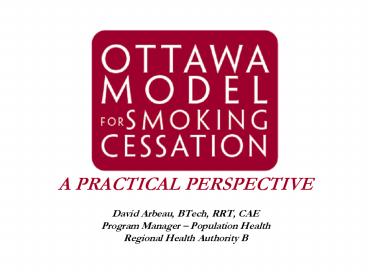A PRACTICAL PERSPECTIVE - PowerPoint PPT Presentation
1 / 30
Title:
A PRACTICAL PERSPECTIVE
Description:
Average LOS is 7 days. Hospitalization increases motivation to quit ... Effect of intensive smoking cessation treatment on hospital admissions and all-cause mortality ... – PowerPoint PPT presentation
Number of Views:65
Avg rating:3.0/5.0
Title: A PRACTICAL PERSPECTIVE
1
- A PRACTICAL PERSPECTIVE
- David Arbeau, BTech, RRT, CAE
- Program Manager Population Health
- Regional Health Authority B
2
Disclosure
- I have been sponsored as a speaker
- in the past by
3
Acknowledgements
- The Expert Team at the
- University of Ottawa Heart Institute
- Dr. Andrew Pipe
- Dr. Bob Reid
- Bonnie Quinlan
- Debbie Aitken
- Melody Dallaire
- Kerri Ann Mullen
4
- Smoking cessation has been recognized for many
years as perhaps the most important intervention
in preventive medicine. - Disappointingly, smoking cessation is not
part of the routine practice for many health care
providers.who see the direct consequences of
this behavioral disorder.
Benowitz NL Prog Cardiovasc Dis 20034699-111
5
The Untapped National Potential
- Hospital-based smoking cessation interventions
are an effective means of increasing cessation
rates and preventing complications and death from
smoking related illness - Hospital-based smoking cessation interventions
are sub-optimally used within the Canadian health
care system - There are currently only a handful of
hospital-based cessation programs operating
nationally
6
The Opportunity in Canada
2,803,300 in-patient hospitalizations each year
20 are current smokers Average LOS 7.2 days
560,660 smokers hospitalized each year
7
Smoking is The Leading Preventable Cause of
Disease and Death in Canada
Cardiovascular Ischemic heart disease Stroke
Vascular dementia Peripheral vascular
disease Abdominal aortic aneurysm
Respiratory COPD Pneumonia Poor asthma control
Cancer Lung Oral cavity/pharynx Laryngeal Esophag
eal Stomach Pancreatic Kidney Bladder Cervical Leu
kemia
Active Smoking
Reproductive Low birth weight Pregnancy
complications Reduced fertility SIDS
Other Adverse surgical outcomes/ wound
healing Hip fractures Low bone density Cataract Pe
ptic ulcer disease
8
For every 100 patients admitted to hospital .
10 have quit leading up to hospitalization 65
of hospitalized smokers want to quit!
8
9
Why Treat In Hospital?
- Average LOS is 7 days
- Hospitalization increases motivation to quit
- Smokers access hospital care in large numbers
- Non-judgmental, unambiguous approach is used to
deliver smoking cessation interventions - Provision of comfort and safety for the patient
treatment of withdrawal symptoms - Management of nicotine withdrawal symptoms that
may lead to a successful cessation attempt
10
Effect of intensive smoking cessation treatment
on hospital admissions and all-cause mortality
44 relative risk reduction in hospital
readmission
77 relative risk reduction in mortality!
Mohiuddin, S. M. et al. Chest 2007131446-452
11
A Very Powerful Intervention
Critchley JA, Capewell S. JAMA200329086-97
12
Projected Outcomes of Preventive Interventions
- Intervention Lives Saved NNT
- Smoking Cessation 328,400 9
- Lipid Lowering 132,777 34
- BP Control 63,282 31
- ACE Inhibitors (CHF) 11,000 N/A
- ß Blockers (MI) 17,023 120
- ASA (MI) 10,365 143
- Coumadin (A.Fib) 3,418 2,014
Woolf AH. JAMA 19992822358-65
13
Cost Effectiveness
Per life-year saved
- In terms of preventive interventions, smoking
cessation is the only prevention activity that
can be expected to save money, with the
reductions in costs of events more than
offsetting the cost of the smoking cessation
programs.
Kahn et al. Circulation. 2008 Jul
29188(5)576-85
14
Smoking Cessation
The single, most powerful preventive
intervention in clinical practice. Bar none.
14
15
The Ottawa Model Identification Documentat
ion Counseling Pharmacotherapy Long-term
follow-up
Reid RD, Pipe AL, Quinlan B. Can J Cardiol
200622775-780
16
Implementation of the Ottawa Model in Canadian
Hospitals
17
Expansion of the OMSC
18
(No Transcript)
19
Transforming clinical practice is a multi-step
process
Gaining commitment
Training key contacts
Assessing the environment
Revising policies
Planning for action
Training front-line
Delivering service
Preparing supports
Gathering data
Measuring results
20
Nicotine Addiction
Nucleus Accumbens
VTA
NICOTINE
NICOTINE FROM SMOKING
LUNGS
21
Nicotine
- A tenaciously addictive drug
- Nicotine withdrawal syndrome
- irritability, anger, restlessness, impatience,
difficulty concentrating, depression, anxiety - Tobacco use also conditioned behaviour
22
Pharmacotherapy
- All smokers trying to quit, except in the
presence of special circumstances, should receive
pharmacotherapy for smoking cessation.
23
Nicotine Replacement Therapy Standard
Orders
24
Automated Telephone Follow UpReady to QuitNot
Ready to Quit Recently Quit2-3 minutes each
callAccess to a smoking cessation counselor
25
TelASK IVR Call
Patients
Counsellor Stations
Internet
TelASK Servers
Clinic Workstations
26
Data Overview
27
Ottawa Model at the University of Ottawa Heart
Institute
- gt 6500 admissions/yr
- gt 1400 smokers/yr
- Assistance provided to 96 of smokers
Long-term cessation rate pre-Ottawa Model
35 Long-term cessation rate with Ottawa Model
50!
28
RCT Evidence
Pat Educ Counsel 2007 66319-326)
Adjusted OR 2.27 adjusted for age, LOS, quit
attempts in past year, reason for hospitalization
29
Effectiveness in 9 Champlain hospitals 6-month
quit rate pre- and post-intervention
30
New Brunswick Update
- 10 hospitals
- Health Canada Project
- Initiated at River Valley Health
- Involves 8 hospitals now
- Mass training implementation
- Physician champions
- Encouraging cessation rates






























